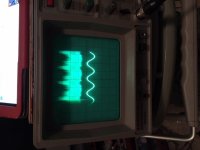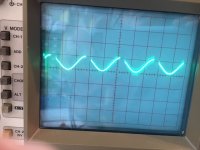I am trying to find the source of the 120Hz buzz coming out of my speakers. At least I think it is 120. Anyhow I disconnected all input to the amp and connected the end of the speaker cable to one of the inputs to the scope. The other input to the scope has a 120Hz from a signal generator. Be aware that I am a total newbie to this and I don't really know what I am seeing on the scope from the amp. I expected a much cleaner picture.
So, am I going about this in the correct manner ?
If not, which is likely, please guide me.
So, am I going about this in the correct manner ?
If not, which is likely, please guide me.
Attachments
It's easy.
60hz is your AC. This can pollute your ground and your amplifier circuit.
120hz is a byproduct of rectification. Rectification is turning the 60hz into a 0hz signal, pure + and ground. or - and ground.
So this comes from the amplifier power supply or a power supply nearby.
60hz is your AC. This can pollute your ground and your amplifier circuit.
120hz is a byproduct of rectification. Rectification is turning the 60hz into a 0hz signal, pure + and ground. or - and ground.
So this comes from the amplifier power supply or a power supply nearby.
Thank you audio, but being the newbie that I am, I am not clear exactly how to do this. I have had it suggested to me before and it had me scratching my head. I have 2 posts dealing with the signal in.
They are:
1) SIG IN
And
2) SIG GND
Am I to run a jumper between these 2 or run a jumper from SIG IN and the chassis ?
They are:
1) SIG IN
And
2) SIG GND
Am I to run a jumper between these 2 or run a jumper from SIG IN and the chassis ?
It's easy.
60hz is your AC. This can pollute your ground and your amplifier circuit.
120hz is a byproduct of rectification. Rectification is turning the 60hz into a 0hz signal, pure + and ground. or - and ground.
So this comes from the amplifier power supply or a power supply nearby.
Thank you gabdx. Can a nearby power supply induce a hum into my circuit ?
Which piece of equipment is doing this ?
The picture shows a 1kHz test tone, except part of it is missing. If I fool around with the scope dials, I can see the missing segment of the curve about 2 inches above the rest of the curve.
Is this a problem with the scope or the signal generator.
Both devices were bought 2nd hand at swap meets.
The picture shows a 1kHz test tone, except part of it is missing. If I fool around with the scope dials, I can see the missing segment of the curve about 2 inches above the rest of the curve.
Is this a problem with the scope or the signal generator.
Both devices were bought 2nd hand at swap meets.
Attachments
Every voltage is between two points. The scope displays the voltage between sig in and sig gnd. If you want to measure 'a voltage' (although there is no such thing) then you need to ensure that the sig gnd is connected to whatever is the reference point for 'the voltage'. This may be signal ground in the circuit, or sometimes the chassis.
Hi Hextejas,
I'll be a bit more specific in technique: I suggest acquiring a RCA phone plug and soldering a short between center pin and ground sleeve. That represents the best possible source--- 0 impedance, no noise, no ground loops.
I also suggest connecting a speaker to the amp. Then you'll be able to hear if the simple act of connecting your scope with its attendant safety ground introduces added hum. A last tip: your scope likely has a Line Trigger option that will ensure the scope sweep is synchronized to the power line.
Good luck!
I'll be a bit more specific in technique: I suggest acquiring a RCA phone plug and soldering a short between center pin and ground sleeve. That represents the best possible source--- 0 impedance, no noise, no ground loops.
I also suggest connecting a speaker to the amp. Then you'll be able to hear if the simple act of connecting your scope with its attendant safety ground introduces added hum. A last tip: your scope likely has a Line Trigger option that will ensure the scope sweep is synchronized to the power line.
Good luck!
One other thing is a ground loop because the scope will be grounded at the plug and at the scope probe. I was a bench tech for Marantz Aus many years ago and (did my apprenticeship there) and one of the old techs showed me to leave the probe ground off in some situations to prevent erroneous signals.
What BSST said about the input short and output stage load is correct. 120Hz is the 2nd harmonic of the mains.
Post 6 is that the output directly from the siggen? or the output from the amp.
What BSST said about the input short and output stage load is correct. 120Hz is the 2nd harmonic of the mains.
Post 6 is that the output directly from the siggen? or the output from the amp.
Thanks Warr and I will try and get to this. I have been busy rewiring and relocating stuff. The sine curve that you see displayed is from a signal generator from an IPad.
After I relocated some wires and rewound them, it has gotten quieter so let me try the above suggestions.
After I relocated some wires and rewound them, it has gotten quieter so let me try the above suggestions.
Maybe you've already established whether the distorted sine wave is a problem in the scope or in the signal generator. If not, a couple of thoughts:
If the displayed waveform evolves as you manipulate scope range switch and/or position knob, it's likely a scope defect. If the shape remains unchanged as you change ranges, probably the IPad. Yet another idea for an independent test signal is to probe a 60 Hz signal within the amplifier's power supply and see if similar distortion presents.
I hope it's only the app. Good luck!
If the displayed waveform evolves as you manipulate scope range switch and/or position knob, it's likely a scope defect. If the shape remains unchanged as you change ranges, probably the IPad. Yet another idea for an independent test signal is to probe a 60 Hz signal within the amplifier's power supply and see if similar distortion presents.
I hope it's only the app. Good luck!
Hi Gabdx; Just thinking out loud here. 120 Hz is a harmonic of the 60hz. You may want to try another 120vac outlet. Also check if there is any type of motor or fluorescent lighting operating on the same circuit. If you have an uninterruptable (standby) power supply used for computers try it. A surge protector strip/outlet may help out if it is a 60 hz harmonic. Performing in older venues I have encountered many "ghost" signals that we had to work around. Good luck
Well, I have all the issues sorted out and it was a valuable learning tool. I jumped right in soldering and ordering parts before I had any semblance of a plan. I learned that the location of the ground wiring was very important and I needed to pay attention to how close it passed to other components. I think that it would have been a good idea that I map things out 1st and plan the layout. I re positioned the toroid so as to locate the wires away from the input from the mains
Ah well, lesson learned.
Ah well, lesson learned.
Bumping this old thread. Built a Dartzeel clone 3 years ago abs it gave good service for those 3 years. Now on one channel I am getting an audible 120hz at the speaker output. It will get a bit worse if I short the input ( as it adds a bit of 60hz). The other channel is fine.
Audio comes out fine....
Audio comes out fine....
Thanks Demian: I added extra caps on the bad side and it subsided significantly.. just audible when I bring my ear near the speaker.
Its a Dual mono topology, so one side PSU caps probably failing. (caps were old/ 30 year old pull outs form an Adcom 545ii ) Will replace all PSU caps with larger units.... I like the sound of this amp. Worth upgrading PSU
Current ones are 10kuF. Adding 6800uF did nothing, per rail. Adding 27kuF did it. Its a Dartzeel kit, semi class A so a lot of ripple...
Its a Dual mono topology, so one side PSU caps probably failing. (caps were old/ 30 year old pull outs form an Adcom 545ii ) Will replace all PSU caps with larger units.... I like the sound of this amp. Worth upgrading PSU
Current ones are 10kuF. Adding 6800uF did nothing, per rail. Adding 27kuF did it. Its a Dartzeel kit, semi class A so a lot of ripple...
Last edited:
- Status
- This old topic is closed. If you want to reopen this topic, contact a moderator using the "Report Post" button.
- Home
- Design & Build
- Equipment & Tools
- 120Hz hum in my amp, and here is a scope picture.


 Threads merged.
Threads merged.